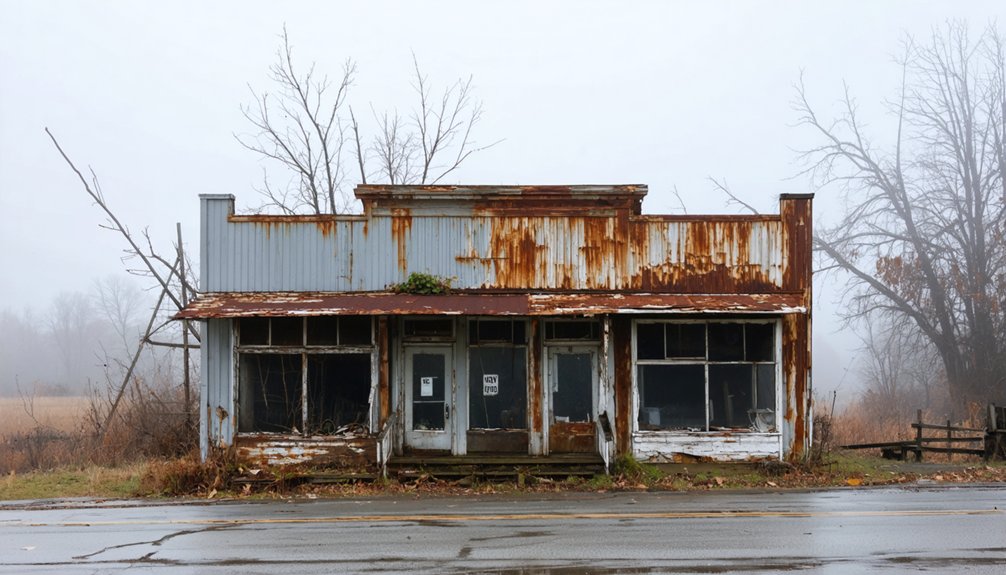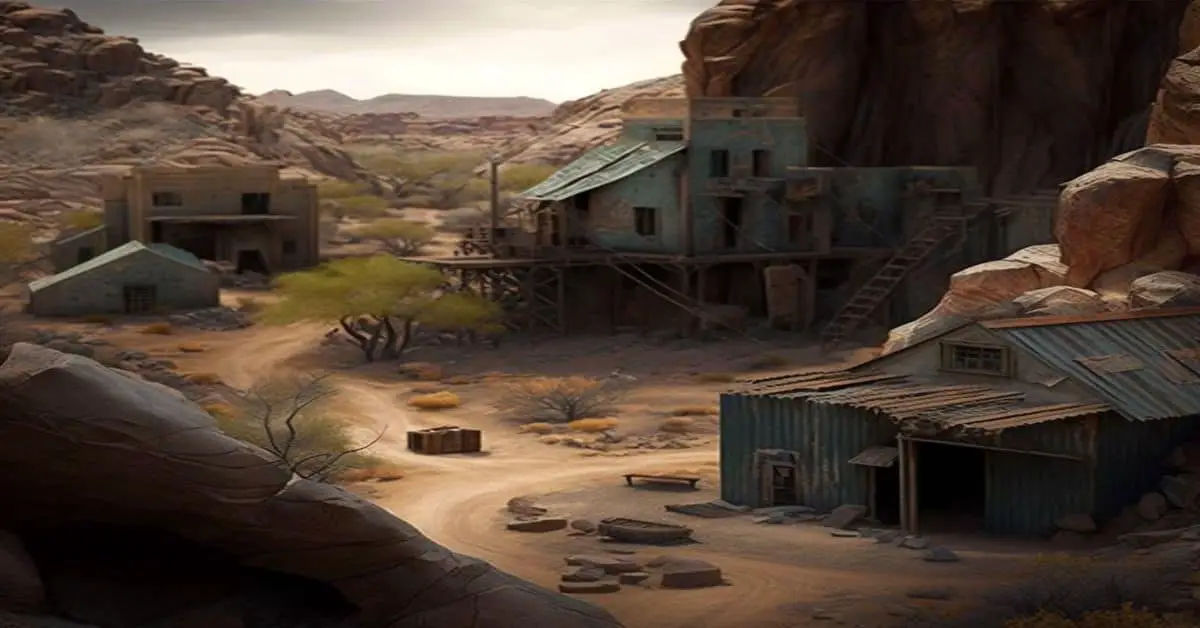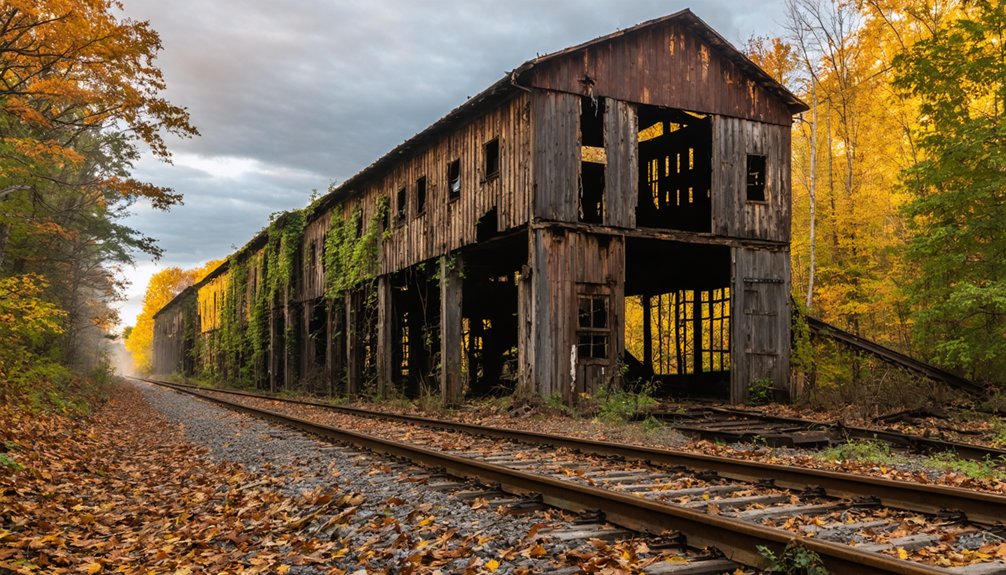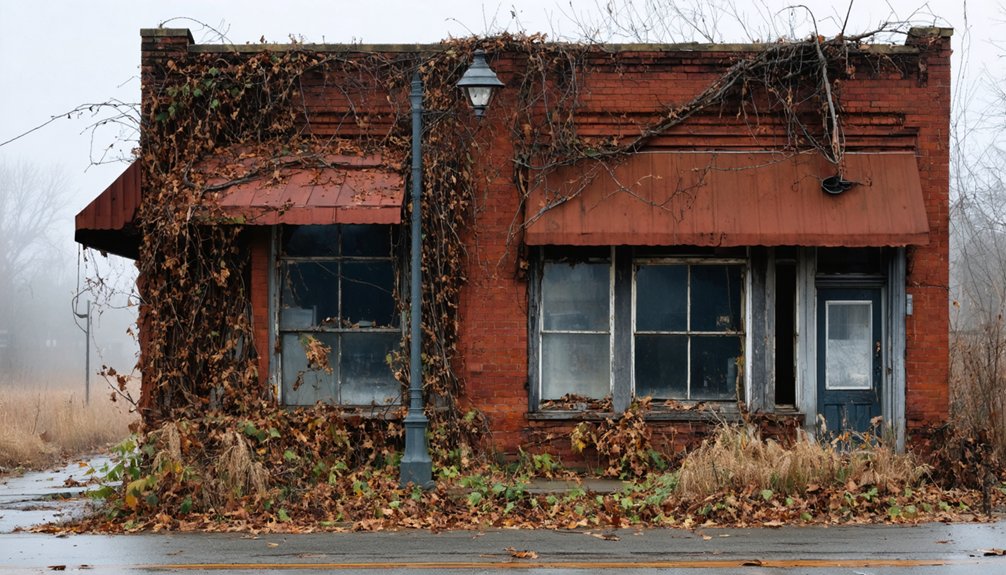You’ll find Marshfield’s ghost town remains in Southern Indiana, where five major railroads once converged to create a bustling hub. Founded in 1857 and named after Daniel Webster’s Massachusetts estate, the town handled 38 daily passenger trains at its peak in 1903. It’s also the site of America’s first major train robbery in 1868, when the Reno Gang struck the Adams Express car. Today, abandoned tracks and scattered structures tell a fascinating tale of Indiana’s railroad heritage.
Key Takeaways
- Founded in 1857 as a railroad stop on the Wabash Railroad, Marshfield began as a thriving transportation hub in Indiana.
- The town gained prominence handling 38 daily passenger trains by 1903, earning the nickname “Hub City.”
- Site of America’s first major train robbery in 1868, when the Reno Gang stole $100,000 from an Adams Express car.
- Declined significantly as newer transportation methods emerged, leading to abandoned rail infrastructure and population loss.
- Now a ghost town with only scattered residences and a grain elevator remaining as evidence of its former railroad significance.
The Birth of a Railroad Town (1857)
The arrival of the Wabash Railroad in 1857 marked the birth of Marshfield, Indiana, transforming empty prairie into a bustling frontier settlement.
From vacant grassland to vibrant pioneer town, Marshfield emerged when steel rails pierced the Indiana prairie in 1857.
As railroad expansion pushed westward, town planning efforts culminated in Marshfield’s official platting on May 22, 1857. You’ll find it fascinating that the town’s strategic location made it an important refueling and watering stop for steam locomotives. Much like other early railroad towns, Marshfield served as a vital supply depot for railway operations.
Within months, Marshfield secured its place on the map with the establishment of a post office on April 6, 1857.
The town’s name paid homage to Daniel Webster’s Massachusetts hometown, reflecting the settlers’ eastern roots. Soon, general stores, blacksmith shops, and a grain elevator sprang up around the tracks, creating a crucial hub for both rail commerce and agricultural trade. The town’s prosperity attracted the attention of the notorious Reno Gang, who would later target trains in the area.
Daniel Webster’s Massachusetts Connection
While many frontier towns borrowed names from prominent figures, Marshfield’s connection to Daniel Webster ran remarkably deep through his distinguished legal and political career in Massachusetts. Webster’s influence extended far beyond his Boston law office at Court and Tremont Streets, shaping both Massachusetts politics and the nation’s future. During his time in Massachusetts, he chaired the House Judiciary Committee and worked to improve the Supreme Court system. His estate featured a Gothic-style library that housed over 3,000 books.
- He maintained an impressive 1,800-acre estate in Marshfield, MA, where he pursued experimental agriculture.
- You’ll find his legacy in Boston’s Union Oyster House, where he’d regularly enjoy oysters and brandy.
- He served Massachusetts both in the U.S. House (1823-1827) and Senate (1827-1841).
- Webster’s final days were spent in his beloved Marshfield, where he died in 1852 and was laid to rest.
His Massachusetts connections weren’t just political – they were deeply personal and enduring.
Rise as a Strategic Rail Hub
Although Marshfield began as a modest frontier settlement, its transformation into a major rail hub started in 1872 when Wisconsin Central Line laid its first tracks through “Section 32” – the area’s original name.
By the 1890s, you’d have seen an impressive network of railroads converging on the town, including the Marshfield & Texas Railroad, Wood County Railroad, and Chicago & Northwestern.
The railroad significance of Marshfield peaked in 1903 when it handled 38 daily passenger trains, second only to Milwaukee in the region.
The economic impact was profound as multiple rail lines merged under larger networks, cementing Marshfield’s position as an essential transportation nexus.
You would’ve witnessed the town earn its “Hub City” nickname through extensive rail infrastructure that connected Chicago, northern Wisconsin, and beyond.
The Omaha line arrived in 1890, adding another crucial connection to the growing rail network.
The station’s importance continued until Soo Line purchased and rebuilt the depot in 1909.
The Infamous 1868 Train Heist
One of America’s most notorious train heists unfolded in Marshfield, Indiana on May 22, 1868, marking the first major train robbery in U.S. history.
You’ll find that these criminal masterminds targeted the Adams Express car during a routine refueling stop, overpowering engineer George Fletcher and making off with nearly $100,000 in cash and bonds – a fortune for that era.
- They uncoupled the express car from the main train, leaving passengers stranded.
- The express messenger was thrown from the train after refusing to open the safe.
- The conductor suffered wounds during the intense gunfire exchange.
- The locomotive and express car were later found abandoned near Crothersville.
The gang had established their headquarters at the Radar House Hotel in Seymour, where they plotted their devastating attacks.
The Reno Gang’s ruthless tactics during this period sparked widespread terror across the Midwest through robbery and murder. The train heist’s aftermath brought swift retribution, with Pinkerton agents capturing several suspects who’d later face vigilante justice at Hangman Crossing.
Reno Gang’s Reign of Terror
During the post-Civil War period, you’ll find the Reno Gang‘s criminal empire reached its peak, with their operations spreading from their Seymour base into Marshfield and surrounding territories.
You can trace their systematic exploitation of weak law enforcement through a string of train robberies, counterfeiting schemes, and burglaries that plagued Indiana from 1865 to 1868. The gang’s rise to power began with their lucrative scheme of bounty jumping during the Civil War. Led by the Reno brothers, the gang’s tight-knit family structure made them especially difficult for authorities to infiltrate.
Their reign of terror exposed critical gaps in post-war policing, forcing communities to rely on vigilante justice when corrupt local officials failed to act.
Criminal Operations Timeline
The Reno Gang’s reign of terror in Indiana began in 1864 with a series of calculated post office robberies in Jonesville, Dudleytown, and Seymour.
Their criminal networks expanded rapidly, establishing a counterfeit operation at the Radar House hotel while terrorizing travelers and exploiting post-Civil War chaos.
The gang’s historical repercussions reached their peak with the infamous Marshfield train robbery in 1868, stealing $97,000 in gold and bonds.
- Early operations focused on post office heists and retail burglaries (1864-1867)
- Counterfeiting ring established at Seymour’s Radar House hotel (1865)
- Multiple train robberies culminating in the Marshfield heist (1868)
- Final downfall through vigilante justice at Hangman Crossing (mid-1868)
You’ll find their criminal empire crumbled under mounting pressure from both the Pinkerton Agency and local vigilante groups.
Post-War Law Enforcement Impact
Following the Civil War’s conclusion, law enforcement agencies struggled to maintain order amid the Reno Gang‘s ruthless crime spree, leading to profound changes in how justice was administered throughout Indiana.
As U.S. Marshals and local sheriffs proved ineffective, vigilante justice emerged through groups like the Jackson County Vigilance Committee, who took matters into their own hands.
The gang’s activities devastated local economies through train robberies and business theft, forcing communities to adapt.
You’ll find that this period marked a significant shift in law enforcement tactics, with Pinkerton detectives implementing new strategies to combat organized crime.
While formal legal proceedings often failed due to corruption and lack of evidence, the rise of vigilantism ultimately brought the gang’s reign to an end, though at the cost of undermining traditional legal authority.
Law Enforcement Evolution and Vigilante Justice
As lawlessness gripped Indiana’s rural communities in the early 1900s, a transformation in law enforcement became vital to maintain order and protect citizens.
You’ll find that before the Indiana Motor Vehicle Police’s establishment in 1921, citizens often took matters into their own hands through vigilante justice, as evidenced by the infamous Reno Gang incident in Marshfield.
- The creation of statewide jurisdiction helped combat cross-county crimes that local sheriffs couldn’t effectively pursue.
- Early law enforcement faced significant limitations, focusing primarily on traffic violations.
- The Great Depression led to agency consolidation, forming the more powerful Indiana State Police.
- Modern training systems replaced the old fragmented approach, establishing standardized law enforcement practices.
These changes marked a significant shift from vigilante-based justice to organized law enforcement, fundamentally reshaping Indiana’s approach to maintaining order.
Railroad Glory Days to Abandonment
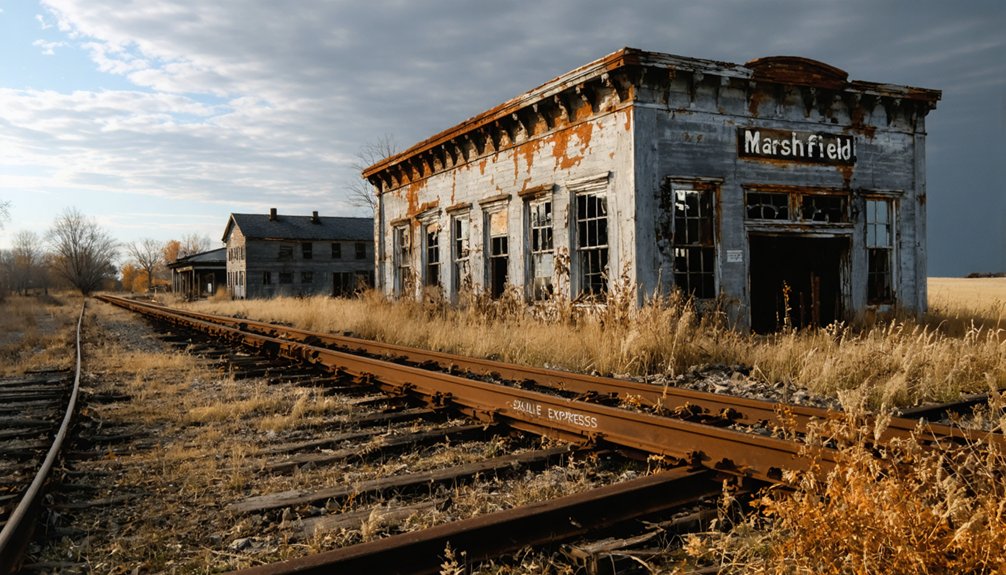
Since steam first powered through Indiana in 1838, Marshfield’s rise and fall has mirrored the dramatic trajectory of America’s railroad age. You’ll find railroad nostalgia embedded in every corner of this former boomtown, where the Jeffersonville, Madison, and Indianapolis Railroad once brought life and prosperity.
As a strategic refueling stop, Marshfield flourished, drawing workers and traders who built their lives around the rhythmic sound of steam engines.
The community transformation was profound but fleeting. By the mid-20th century, you could witness the slow decline as newer transportation methods emerged. The once-bustling station, where the infamous Reno Gang struck in 1868, fell silent.
Today, abandoned tracks and weathered structures stand as evidence of Marshfield’s golden era, when the power of rail drove the American dream forward.
Legacy Through Historical Markers
The legacy of Marshfield endures through Indiana’s historical marker program, standing sentinel at US 31 and Terrell Road near Scottsburg’s northern limits.
You’ll find this evidence of historical significance installed in 2002 through collaborative efforts between the Indiana Historical Bureau and local preservation groups. The marker serves as an essential educational tool, highlighting the infamous train robbery that put this ghost town on the map.
Key aspects of the marker’s impact include:
- Preserves community pride by commemorating Marshfield’s role in state history
- Provides an accessible learning opportunity for heritage tourism
- Guarantees the story lives on through carefully researched documentation
- Creates a tangible connection between modern visitors and the area’s railroad past
Scott County’s Lost Settlement
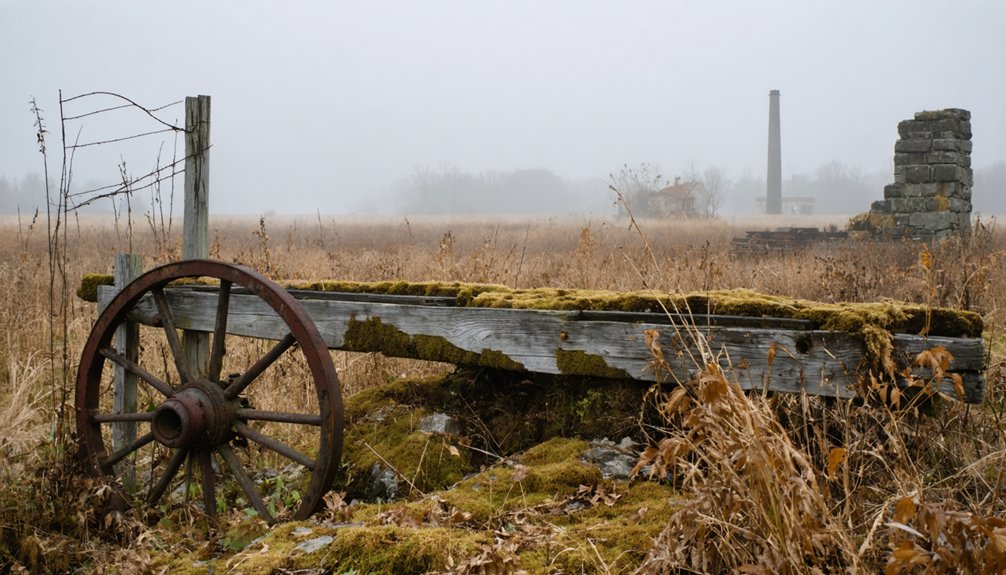
You’ll find Marshfield’s origins deeply tied to its strategic location on the Jeffersonville, Madison and Indianapolis Railroad, where it served as a crucial water stop and refueling station in the mid-1800s.
The town’s establishment in 1857 quickly attracted businesses, churches, and residents seeking opportunities in this Vienna Township settlement situated three miles northwest of Scottsburg.
As railroad transportation evolved and the town’s strategic importance diminished, Marshfield gradually transformed from a bustling railway stop into today’s ghost town, with only scattered residences and a grain elevator marking its former significance.
Railroad Roots and Decline
Located along the Jeffersonville, Madison, and Indianapolis Railroad (JM&I), Marshfield emerged as an essential refueling and watering stop during the mid-19th century.
The railroad expansion transformed this small settlement into a strategic point for train operations, driving economic impact throughout the region. You’ll find that Marshfield’s rise and fall directly tied to its railroad roots.
Here’s what made Marshfield significant in railroad history:
- Served as a vital stop between major towns like Scottsburg and Austin
- Facilitated transport of valuable U.S. treasury notes and government bonds
- Became notorious after the 1868 Reno Gang train robbery of $98,000
- Declined when advancing train technology eliminated the need for frequent stops
As railroad logistics evolved and nearby towns grew, Marshfield’s importance faded until it became the ghost town you’ll discover today.
Early Settlement and Location
While Marshfield’s railroad prominence shaped its later history, its roots stretch deeper into Scott County’s past as a pioneering settlement.
You’ll find this historic ghost town about three miles northwest of Scottsburg, nestled in Vienna Township’s rolling terrain. The historic geography of the area features fertile plains typical of Southern Indiana, which early settlers cultivated for agriculture.
Though exact founding dates remain unclear, you’ll discover that Marshfield was established before the Civil War, making it one of the area’s earlier settlements.
Today, you can explore the surrounding landscape, which includes the Scottsburg Reservoir and Stucker Fork Fish and Wildlife Area. The site’s agricultural heritage is still evident in the farmland that continues to dominate the local landscape, even though the town itself has vanished.
Ghost Towns of Southern Indiana
Throughout Southern Indiana’s landscape, numerous ghost towns stand as silent witnesses to the region’s rich railroad heritage, with Marshfield serving as a prime example of these forgotten communities.
As railroad expansion shaped the region’s development, these towns flourished briefly before succumbing to economic decline and changing transportation needs.
You’ll find these common patterns among Southern Indiana’s ghost towns:
- Towns initially thrived as essential railroad water stops and commerce hubs
- Economic shifts and declining rail traffic led to population exodus
- Post-Civil War instability and vigilante justice disrupted community stability
- Environmental conditions and failed industries hastened town abandonment
These ghost towns tell a compelling story of freedom, opportunity, and ultimate transformation as the region evolved beyond its railroad-dependent past, leaving only scattered remnants of once-bustling communities.
Frequently Asked Questions
Are There Any Remaining Buildings or Structures in Marshfield Today?
You won’t find any ghostly remnants or architectural history there today, as no verified structures remain. Research shows no documented buildings in what would’ve been Marshfield’s original location.
What Happened to the Original Residents of Marshfield?
Like scattered seeds in the wind, displaced families migrated to growing urban centers like Scottsburg. Historical records show you’d find most original residents sought better economic opportunities after the railroad’s decline.
Can Visitors Access the Site of the Historic Train Robbery?
You can access the train robbery site via the historical marker at US 31 and Terrell Road in Scottsburg. While you’ll see active railroad tracks, there’s safe visitor access through public roads.
Were There Any Schools or Churches Established in Marshfield?
Through rising and falling fortunes, you’ll find records of three religious organizations that served Marshfield in the late 1800s, but there’s limited documentation about educational institutions beyond what the churches might’ve provided.
What Was the Peak Population of Marshfield During Its Railroad Heyday?
You’ll find that even during its railroad impact peak in the late 1800s, Marshfield never exceeded 250 residents, though local ghost stories suggest more souls lingered around this bustling stop.
References
- https://www.youtube.com/watch?v=45D4dbASJyE
- https://www.in.gov/history/state-historical-markers/find-a-marker/marshfield-train-robbery/
- https://www.legendsofamerica.com/we-renogang/
- https://www.hmdb.org/m.asp?m=238562
- https://wikimapia.org/34624214/Marshfield-Indiana
- https://en-academic.com/dic.nsf/enwiki/1818710
- http://ingenweb.org/inlawrence/abandoned.htm
- https://en.wikipedia.org/wiki/List_of_ghost_towns_in_Indiana
- https://en.wikipedia.org/wiki/Timeline_of_Warren_County
- https://www.ebay.com/itm/187332954759
